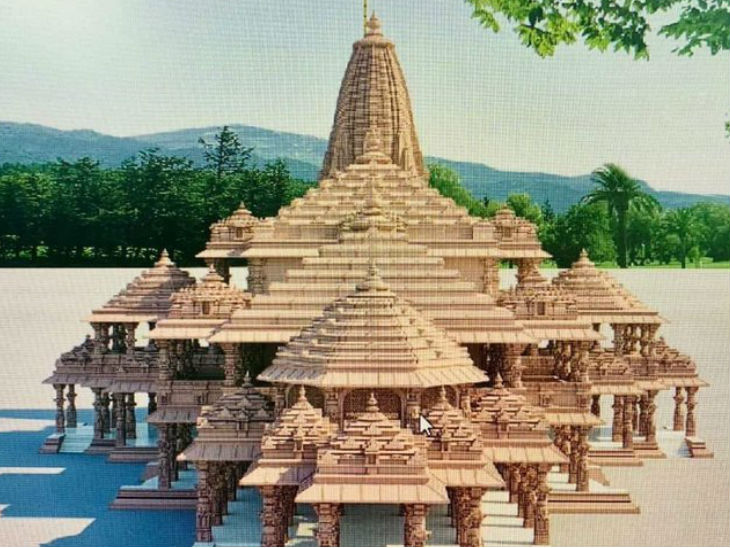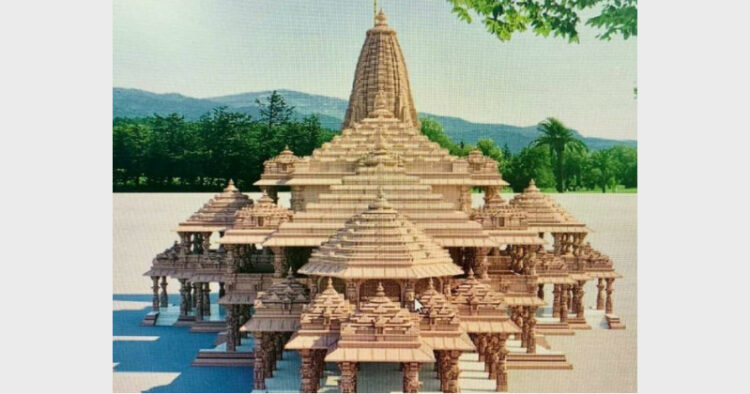
Ganesh Puthur
Bharat’s 500-year-old civilisational struggle for reclaiming Ram Janmabhumi ended with Prime Minister Narendra Modi performing Bhoomi pujan for the construction of Bhavya Ram Mandir in Ayodhya on August 5th. Though the beginning of temple construction has lead to meltdown among Islamists and Communists, the nation has welcomed the Bhoomi pujan by lighting ‘diyas’ and distributing sweets. While addressing the spiritual gurus post the ceremony, PM Modi recapitulated the idea of ‘Rama Rajya’ popularised by Mahatma Gandhi. He also commemorated the sacrifices made by devotees spanning 5 centuries and asked the nation to draw inspiration from the Ram Temple which will again come at the exact spot where it was demolished by invaders.
Much has been said and written about the history of Ayodhya and the disputed structure which stood over the Ram Janmastan until 1992, the year on which it was finally razed down by the Hindus. During medieval times, Islamic invaders often destroyed or converted temples to Masjids. There are enough archaeological and written records to substantiate that thousands of Hindu temples had been demolished with idols dismantled, ranging from Kashmir to Kanyakumari. Ayodhya is just once among the most revered temples snatched from Hindus by the Islamic tyrants.
In 2003, excavations were carried out by Archaeological Survey of India (ASI) in Ram Janmabhumi. Remains of a large temple complex dedicated to Lord Ram were found which confirmed the existence of a temple before being demolished by Mir Baqi in 1528 following Babur’s order. In its 2010 verdict, the Allahabad high court too upheld the ASI findings. As written by eminent archaeologist K K Mohammed in his autobiography, it was the lobby of Marxist historians who peddled fake allegations claiming that the discovered remains were planted by ASI due to political compulsions. Historians in the initial stage were reluctant to accept that the disputed structure was build after demolishing a Hindu temple. Later they accepted demolition of the grand temple but continued to oppose the construction of Ram Mandir at the exact spot. Academicians and Historians allied with the ‘Quam-Red’ faction have clubbed demolition of the disputed structure in 1992 with ‘Hindu Fascism’ and ‘cultural nationalism’. But they always chose not to condemn fanatic invaders for the destruction and looting of Hindu temples.
In the last minute to the run-up of Bhoomi pujan, Congress Party’s sudden love for Lord Ram caught everyone by surprise. The same Congress Party had dissociated themselves from the construction of Somnath Temple in Gujarat with Pandit Nehru (who chose to be a European in his world view) writing off the construction as mere ‘Hindu revivalism’. The same party in 2007 told the Supreme Court that there was no proof for the existence of Lord Ram. Now their senior leaders are standing in queue for donating money to Ram Janmabhoomi Teerth Kshetra Trust which monitors the construction of Ram Mandir. But unfortunately for the grand old party their ally in Kerala- Muslim League launched a strong protest to the party’s high command for a statement made by Party’s General Secretary and UP in-charge Priyanka Gandhi. Interestingly the same Muslim League had welcomed the decision of Turkey’s Supreme Court to convent Hagia Sophia (originally a cathedral made by Justinian I) to Mosque. It will be interesting to see whether the Congress dump their prospectus in the entire nation for just two or three Lok Sabha seats that the Muslim League can bring in.
The narrative of Muslim victimisation in India has been woven around the Karseva of 1992. In these days, much propaganda works were seen on the Editorial pages of leading national dailies. To further expose their hypocrisy, editorials also contained articles which lamented for the people of Jammu and Kashmir since August 5th also marked the anniversary of the abrogation of Article 370. No newspapers left space for the story of Kashmiri Hindus who were thrown out of Kashmir long before the demolition of the disputed structure.
Coming back to Ayodhya, the temple town is all set to take a makeover. Ayodhya had been ignored by successive state governments and had been left with trembling infrastructure. The present dispensations (both at the State and Central levels) have initiated multiple projects that will eventually develop the city to accommodate millions of people who will flock to Ayodhya after the construction of Bhavya Ram Mandir. As mentioned by PM Modi, there are multiple Ramayanas indigenous to almost all nations in south and south-east Asia. But there is only one Ram and one Ayodhya. Hence, Ayodhya is ‘Punyabhumi’ to every Indian who inherits the goodliness of Lord Ram.
What we see in Ayodhya is the resurgence of the soul of Bharat, rising up from the shambles of past and finally overcoming all the attempts of the invaders spanning centuries to destroy our culture and legacy.
(The writer is a Masters student at Hyderabad Central University)














Comments